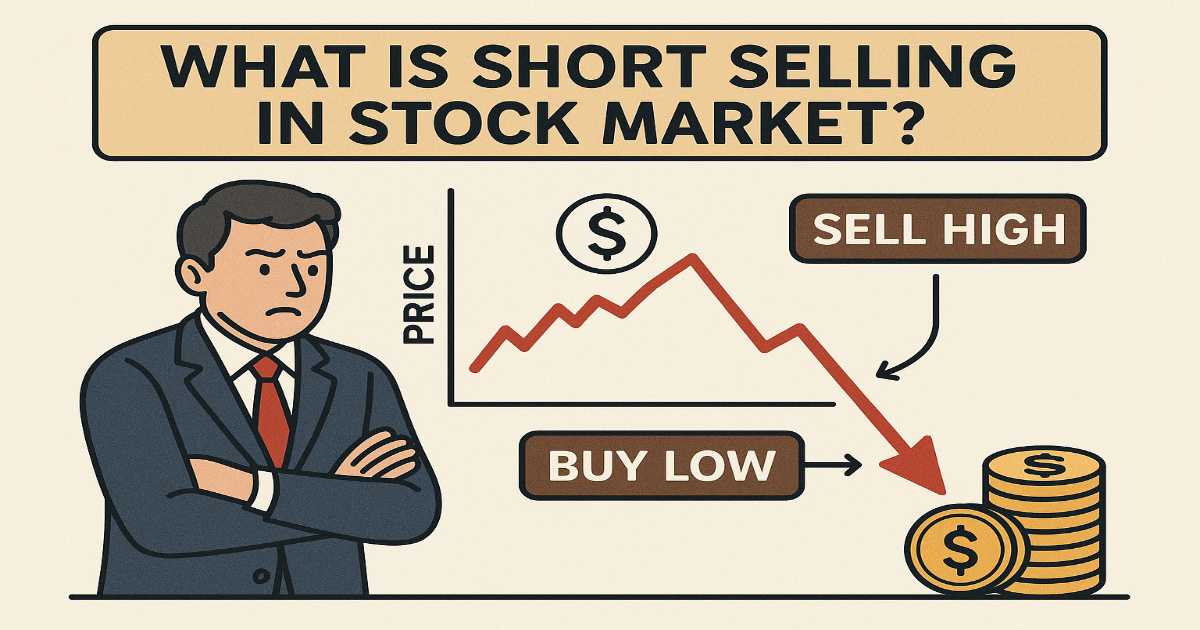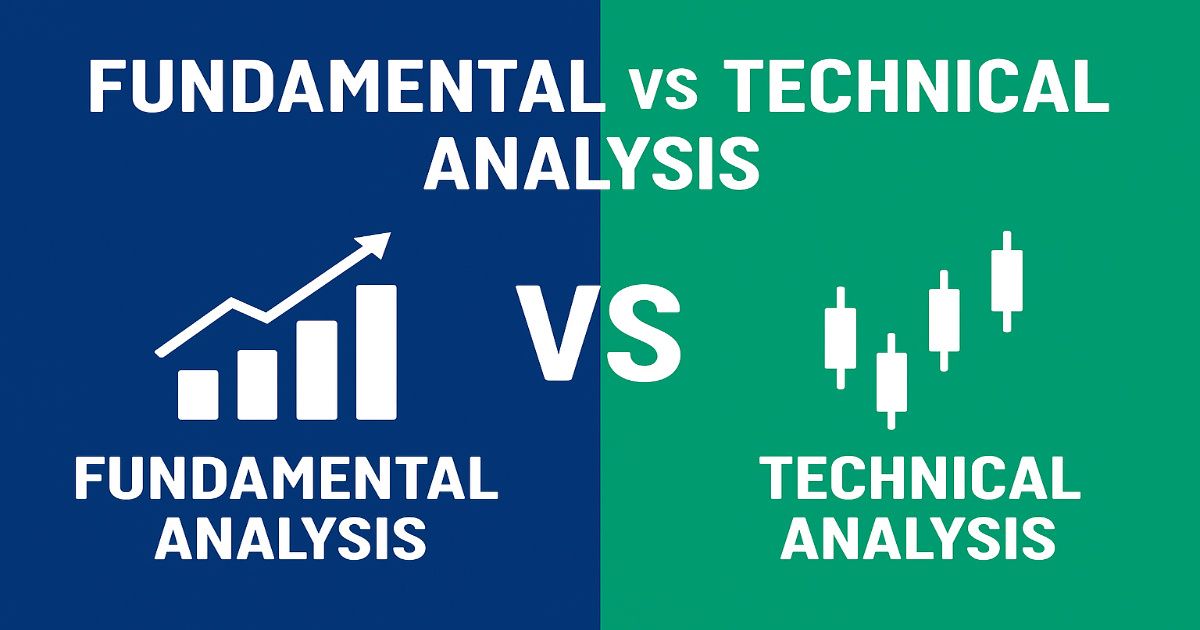When we think of stock market investing, the typical idea is: buy low and sell high. But what if you could do the opposite — sell high first, then buy low later — and still make money? That’s exactly what short selling is all about. Short selling is a strategy used by traders to profit from falling stock prices. While it’s popular in global markets, Indian traders are also using it — especially in intraday trading and the derivatives segment. However, it comes with higher risk and requires deep market understanding.
What is Short Selling?
Short selling is a trading technique where a trader sells a stock that they do not own, hoping to buy it back later at a lower price. The idea is to profit from the fall in the stock’s price.
In short selling, you borrow the shares (typically from a broker), sell them in the market, and later repurchase them to return to the lender. The difference between the selling price and the repurchase price becomes your profit (or loss). Short selling, as opposed to a long position, is an investment strategy with the underlying motive of “buying low and selling high.” Investors who short-sell stocks expect share prices to drop in the future and aim to capitalise on this prediction.
How Does Short Selling Work?
Let’s break it down into steps:
- Borrow the Shares: You borrow shares from a broker (brokerage firm).
- Sell in the Market: Immediately sell them at the current market price.
- Wait for Price to Drop: Hold your position, hoping the price will fall.
- Buy Back the Shares: Purchase the same quantity at the lower price.
- Return to Broker: Deliver the borrowed shares back.
- Profit: You make money if the price fell, or suffer a loss if it went up.
Example of Short Selling
Let’s say:
- You expect that Tata Motors stock will fall.
- You short sell 100 shares at ₹600 each = ₹60,000.
- After 2 days, the price drops to ₹540.
- You buy back the shares = ₹54,000.
- Your profit = ₹60,000 – ₹54,000 = ₹6,000.
But if the price rises to ₹650, your loss = ₹5,000. That’s why short selling is risky.
Why Do Investors Short Sell?
Investors and traders short sell for various reasons:
- Profit from Falling Markets: If a trader believes a stock is overvalued, shorting helps them earn when it drops.
- Hedging: Fund managers may short sell stocks to hedge against other investments.
- Bearish Outlook: When market sentiment is negative, short selling offers an opportunity to make gains.
- Speculative Strategy: Some experienced traders use it as a part of momentum or trend-following strategies.
Where Can You Short Sell in India?
In India, short selling is allowed under specific regulations:
- Cash Segment (Equity): You can short sell for intraday only. All positions must be squared off before the market closes.
- F&O Segment: You can short sell and carry forward positions in futures and options contracts.
Note: You must have a margin trading account and enough collateral to cover the risk.
When Does Short Selling Result in Loss?
When traders wrongly predict the decline of share prices, they stand to lose infinitely. The term “infinite risk” particularly applies to short selling, where the modus operandi is “sell high and buy low”.
In the conventional trading approach, a trader purchases shares at a specific price and expects them to rise in the future when she can sell them to earn profits. In that case, even if the share prices fall, a trader only stands to lose to the extent of his/her investment. This denotes limited risk as a result. In case of short-selling stocks, if the share prices surge, they can skyrocket infinitely as well. Hence, it exposes a trader to unlimited risk.
Short selling example – Ruth speculates that PNM stocks will fall in value from their current market price of Rs. 100 when the company announces its dismal annual reports the following week. Relying on this speculation, she borrows 15 PNM stocks and concludes short selling in the stock market at Rs. 100/share. However, just after the announcement of the annual report, the company was overtaken by a reputed conglomerate, thus driving its share prices upwards to Rs. 110. Ruth then decides to close the position and buy back the shares at the increased market rate. She, therefore, realises a loss of Rs. 10/share, and Rs. 1500 (15 x 10) overall in addition to the interest and commission.
Short Selling vs Regular (Long) Buying
| Feature | Long Buying | Short Selling |
|---|---|---|
| Goal | Buy low, sell high | Sell high, buy low |
| Market Sentiment | Bullish | Bearish |
| Ownership of Shares | Buy and own | Borrow and sell |
| Risk | Limited (to invested amount) | Unlimited (stock can rise forever) |
| Time Frame in India | Intraday or long-term | Intraday (equity), F&O (carry) |
Pros of Short Selling
- Profit in Bear Markets: It gives traders an opportunity to earn when markets are falling.
- Hedging Tool: It helps to reduce losses in a falling market, especially in portfolios.
- Market Efficiency: Short sellers can expose weak companies or overvalued stocks.
- Leverage: Short selling allows making larger trades with limited capital using margin.
Risks and Disadvantages
- Unlimited Loss Potential: If stock price rises instead of falling, losses are infinite.
- Margin Calls: Brokers can demand extra funds if the stock price rises unexpectedly.
- Short Squeeze Risk: When too many traders short the same stock, it can trigger panic buying.
- Borrowing Costs: You pay a fee to the broker to borrow the shares.
- Timing is Critical: You must be accurate about both direction and timing.
When is Short Selling Profitable?
Short selling becomes profitable when a trader correctly speculates that a stock’s price will decline after selling it. In such cases, the trader sells borrowed shares at a higher market price and later repurchases them at a lower price, keeping the difference as profit. For instance, suppose Rahul believes stock ABC, currently trading at ₹200, is overvalued and will drop after its quarterly results. He borrows 20 ABC shares and sells them at ₹200, going “short” on the stock. A week later, ABC falls to ₹175, and Rahul buys back the 20 shares at this new lower price. He profits ₹25 per share, or ₹500 in total (₹25 × 20 shares), and returns the shares to the broker. While the calculation shows a profit of ₹500, actual returns are reduced by interest on borrowed shares, brokerage fees, and possibly dividends that Rahul may owe the share buyer during the holding period. Moreover, if many traders are shorting the same stock, it can reduce share availability and drive up borrowing costs. There’s also no guarantee of liquidity — finding buyers or sellers at the right price may be challenging, making short selling a high-risk strategy despite its profit potential.
What is a Short Squeeze?
A short squeeze happens when a heavily shorted stock suddenly starts rising. Short sellers rush to cover their positions (buy back), which leads to even more buying, pushing prices higher quickly.
Famous Example:
GameStop (GME) in 2021 — retail traders pushed the price up and caused huge losses to short sellers and hedge funds.
Rules and Regulations of Short Selling in India
- Allowed for all investors: Retail and institutional investors can short sell.
- Only Intraday in Equity: Positions must be squared off before market close.
- F&O Segment is Flexible: You can carry short positions overnight or for weeks.
- Mandatory Reporting: Institutional short selling needs to be reported to SEBI.
- Naked Short Selling is Banned: You must have a proper arrangement to borrow shares.
- Stock Borrowing Mechanism: SEBI has a Stock Lending and Borrowing (SLB) mechanism.
Famous Cases of Short Selling
- Big Short (2008 Crisis): Investor Michael Burry shorted the US housing market and made billions.
- GameStop Saga (2021): Retail investors took on hedge funds and triggered a short squeeze.
- Hindenburg vs Adani (2023): US-based Hindenburg Research released a report alleging fraud, causing Adani stocks to crash. Traders made profits shorting Adani stocks in global markets.
Final Thoughts
Short selling is a powerful tool in a trader’s arsenal — but it comes with high risks. If used wisely, it allows investors to profit even in falling markets. But for that, one needs strong research, risk control, and emotional discipline.
In India, short selling is mainly used for intraday equity trades and derivatives trading. With the rise of stock lending platforms and better risk systems, short selling is becoming more accessible, but it’s still best left to experienced traders.
FAQs
Is short selling legal in India?
Yes, short selling is legal under SEBI rules for both retail and institutional investors.
Can I short sell a stock and hold it overnight?
No, in equity cash segment you must square off the trade intraday. For overnight positions, use F&O.
Is short selling risk?
Yes, it has unlimited loss potential. Proper risk management is essential.
What is the benefit of short-selling?
Short Selling increases market liquidity, which may lower stock prices, increase bid-ask spreads, and aid in price discovery.
What’s the difference between short selling and put options?
Short selling involves selling borrowed shares; put options are derivatives that give you the right to sell at a fixed price.
How do I start short selling in India
You need a trading and demat account, margin facility enabled by your broker, and access to either intraday trading or F&O segment. You can then short sell stocks on the trading platform.
Can I short sell without using margin or leverage?
No. Short selling typically requires margin because you’re selling something you don’t own. The broker provides you with borrowed shares and expects a margin to cover the risk.
Are there any time limits for short selling in India?
Yes. In the cash segment, you must close the short position the same day (intraday). In F&O, you can hold the position till expiry or as long as the contract allows.
Why is margin trading also known as short selling?
Short selling is also known as margin trading, and it involves a trader borrowing money from a brokerage firm by utilizing an asset known as collateral. The brokerage business required all traders to keep a specific percentage of their funds in their accounts.
Disclaimer
This article is for educational purposes only. Stock market investments are subject to market risks. Please consult a SEBI-registered financial advisor before making any investment or short selling decisions.







